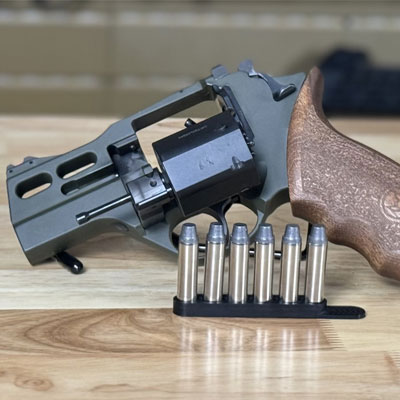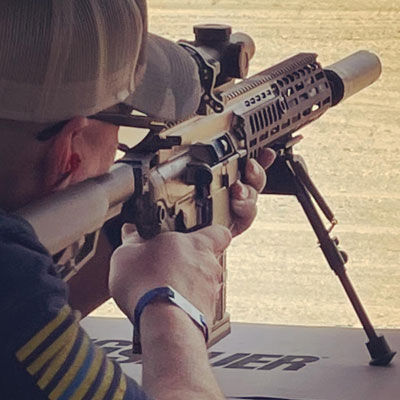# **Staccato P4: A Closer Look at the Newest Staccato 2011**
The **Staccato P4** takes a different approach compared to previous models, introducing key changes that set it apart from the rest of Staccato’s lineup. From its **firing pin block and flat-wire recoil system** to its **Glock magazine compatibility and grip safety delete**, this pistol is clearly built with duty use in mind.
Now that I’ve spent more time with the **P4**, let’s break down how these changes impact performance and whether this is the **best duty-ready 2011 on the market**.
## **Key Changes in the Staccato P4**
Staccato made several **major design updates**, including:
- **Firing pin block** – Added safety feature to prevent accidental discharge.
- **Flat-wire recoil system** – Improved durability and smoother cycling.
- **More aggressive grip texture** – Similar to the **Stealth Arms Platypus** but with a finer texture.
- **Grip safety removed** – First Staccato model to eliminate it.
- **Controls set further back** – Easier slide and mag release manipulation.
- **Glock magazine compatibility** – No more proprietary Staccato mags.
- **Rear sight positioned forward of the optic** – A small but notable design tweak.
- **Fluted barrel underside** – Likely for weight reduction and heat dissipation.
## **Firing Pin Block – A First for Staccato**
The **firing pin block** is a **big change**, especially for a Staccato. This **safety mechanism prevents the firing pin from moving unless the trigger is fully pressed**, reducing the risk of accidental discharge.
For **duty and law enforcement applications**, this is a **huge advantage**. However, some shooters argue that a **firing pin block can create a “mushy” trigger**.
After testing it, I noticed **a bit more take-up**, but it wasn’t a dealbreaker. It’s **not as light as the XC**, but that’s expected—this is a **duty/carry gun**, not a competition pistol.
## **Flat-Wire Recoil System – Does It Matter?**
Staccato **ditched the traditional round wire recoil spring** in favor of a **flat-wire system**, which improves **durability and cycling reliability**. It’s also **supposed to reduce felt recoil**.
While the **P4 already shoots flat**, I did notice that **racking the slide feels smoother**, with **slightly more resistance up front** compared to older Staccatos.
However, one downside—the **beavertail can be rough on your hand**, making it feel like the **gun is fighting back** during extended shooting sessions.
## **Grip Texture & Ergonomics**
The **P4’s grip texture** is **more aggressive than the Staccato P or C2**, offering **solid control in wet or dry conditions**.
It reminds me of the **Platypus’ prickly texture**, but with a finer pattern. Staccato also **added indented ledges** for your **index finger or thumb**, allowing you to apply downward pressure for **better recoil control**.
## **Grip Safety – Gone for Good?**
Another first for Staccato—the **grip safety is completely removed**.
For those accustomed to **traditional 2011s**, this might take some adjustment. However, **many shooters already tape or pin their grip safeties**, so removing it **eliminates a potential failure point**.
That said, this **might be why the P4 feels rougher on the hand**—without a grip safety to absorb recoil, you’re taking the full force of every shot.
## **Glock Mag Compatibility – Does It Work?**
The **biggest selling point** of the P4 is its **Glock magazine compatibility**. No more proprietary **Staccato mags**—this pistol runs **widely available Glock-pattern magazines**.
I tested several brands, and here’s how they performed:
✅ **OEM Glock mags** – Ran flawlessly.
✅ **KCI & Magpul Glock mags** – No issues.
❌ **Mec-Gar mags** – Some reliability problems, as seen in other Glock-compatible firearms.
If you plan on stocking up on mags, **stick with OEM, KCI, or Magpul** for the best reliability.
## **Optic Mounting – Not Perfect**
Initially, I thought the P4 included an **optic plate**, but that was incorrect.
You can **direct mount certain optics**, but it **leaves a gap and puts strain on the mounting screws**. Given that most **optic screws aren’t the most durable**, I’d recommend **getting the optics plate separately**.
I’m not a fan of this—when you’re spending **this much on a pistol**, it should be **fully optic-ready out of the box** without extra purchases.
## **Disassembly & Reassembly – Small but Notable Changes**
The **breakdown process** is familiar for anyone who’s taken apart a Staccato before, but there are **a few differences**:
- **Slide stop removal** – The **“half-moon” notch is gone**; now, you remove the **slide stop from the locked-back position**.
- **Ambidextrous slide stop** – Makes **reassembly trickier** than older Staccato models.
It’s not difficult, but **first-time users may find it slightly finicky**.
## **Final Thoughts – Is It Worth It?**
After **more time with the P4**, here’s what stands out:
✅ **Excellent grip texture and finger ledges**.
✅ **Firing pin block and grip safety delete** make it feel like a **modernized 2011**.
✅ **Glock mag compatibility** is a game-changer, but **long-term reliability is still unknown**.
✅ **Flat-wire recoil system is subtle but effective**.
❌ **Price point is steep**, and **you still need to buy an optics plate separately**.
Staccato has built a **strong reputation in the 2011/1911DS world**, and **that reputation comes at a cost**. Whether **these changes justify the price** depends on your needs.
I’ll be **pitting the P4 against the Stealth Arms Platypus and the Fusion Firearms XP Pro** to see how it stacks up.
Would you pick up the **P4**, or are you sticking with a more traditional 2011?
## **Follow for More Firearm Reviews & Testing**
For more **in-depth firearm reviews and comparisons**, check out:
- [YouTube](https://www.youtube.com/@RazorMP_Official)
- [Rumble](https://rumble.com/c/RazorMP)
- [Instagram](https://www.instagram.com/razor.mp)
- [X (Twitter)](https://x.com/RazorMP_actual)






